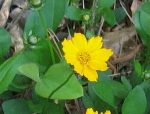A lso called mouse-ear tickseed, this bushy herbaceous perennial is a member of the aster family, Asteraceae, that also includes sunflower, daisy, and lettuce. It is native to southeastern and east-central US where it grows along roadsides and in open woods. Plants grow 4-2 inches tall and form dense colonies by means of stolons. The dark green evergreen leaves are rounded, hairy, and often have one or two ear-like leaflets at the base of the blade that resemble mouse ears. The flowerheads are 1-2″ across and are held singly well above the foliage in spring to early summer. Each flowerhead has a center of yellow disc flowers surrounded by eight ray flowers with toothed tip. The fruit are one-seeded. Bloom time can be extended by deadheading but summer heat usually inhibits flowering. Lobed tickseed is a good choice for borders, rock gardens, or as an edger. The genus name, Coreopsis, comes from the Greek words koris meaning bug, and opsis meaning like and refers to the appearance of the seeds. The specific epithet, auriculata, is from the Latin word auris meaning ear and refers to the appearance of the leaflets at the base of the leaves.
lso called mouse-ear tickseed, this bushy herbaceous perennial is a member of the aster family, Asteraceae, that also includes sunflower, daisy, and lettuce. It is native to southeastern and east-central US where it grows along roadsides and in open woods. Plants grow 4-2 inches tall and form dense colonies by means of stolons. The dark green evergreen leaves are rounded, hairy, and often have one or two ear-like leaflets at the base of the blade that resemble mouse ears. The flowerheads are 1-2″ across and are held singly well above the foliage in spring to early summer. Each flowerhead has a center of yellow disc flowers surrounded by eight ray flowers with toothed tip. The fruit are one-seeded. Bloom time can be extended by deadheading but summer heat usually inhibits flowering. Lobed tickseed is a good choice for borders, rock gardens, or as an edger. The genus name, Coreopsis, comes from the Greek words koris meaning bug, and opsis meaning like and refers to the appearance of the seeds. The specific epithet, auriculata, is from the Latin word auris meaning ear and refers to the appearance of the leaflets at the base of the leaves.
Type: Herbaceous perennial
Bloom: Solitary flowerheads 1-2″ across with yellow disc flowers and eight ray flowers in spring to early summer
Size:1-2′ H x 1′ W
Light:Full sun
Soil:Average, medium moist, well-drained
Hardiness: Zones 4-9
Care: Deadhead to prolong bloom
Pests and Diseases: None of significance
Propagation: Seed, division
Companion Plants: Iris, Salvia, Geranium ‘Johnson Blue’
Outstanding Selections:
‘Nana’ (dwarf, 6″)
‘Superba’ (2-3″ wide flowers with maroon center)